Geologist: The weird thing about the Hawaii eruption
By Einat Lev
Updated 8:56 AM ET, Wed May 9, 2018
Einat Lev, a volcanologist, is an assistant research professor at the Lamont-Doherty Earth Observatory at Columbia University. Her research, funded by the National Science Foundation, is focused on lava flow dynamics at different volcanoes, including in Hawaii. The opinions expressed in this commentary are solely those of the author.
(CNN)When asked to draw an erupting volcano, most people draw a steep-sided cone with a big plume of smoke coming off the top. It will likely be a very scary picture, a "run for your life!" situation. This might be why the current eruption of Kilauea volcano, in Hawaii, has surprised many.
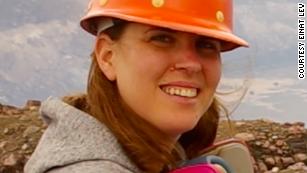
Einat Lev
This eruption, while typical for Hawaii, doesn't look like that picture. Instead, here we are dealing with an "effusive fissure eruption" on the flank of a shield volcano. This means lava is oozing out of cracks in the ground, on the side of a volcano that is low and wide.
Running is not necessary -- a typical flow from this eruption moves a few feet per second, so walking is probably fine (but do get away!)
Lava -- molten rock flowing on the ground for everyone to see -- can be as beautiful as it is dangerous. There is a whole zoo of forms and shapes that lava can take. It can be thick and sticky, building large mounds like the dome that grew in the barren summit of Mount St. Helens between 2004 and 2008, and is still there.
In extreme cases, lava can be very runny and rush down a mountainside in just a few hours, as happened at Nyiragongo volcano in Africa in 2002. The surfaces of lava flows can be smooth and shiny sheets, or rough, painful to walk on, or rubble, or anything in between.
Understanding how lava will behave once it erupts is my focus and passion, and the current eruption is an opportunity to apply what we know to help a community handle an emerging disaster as it unfolds. While we cannot tell how long this eruption will last, we can do our best to predict where the lava will go. Then, once the eruption does end, it will be time to assess how and where the community can rebuild.
The lava from the current eruption at Kilauea has luckily not claimed any lives, but nonetheless has driven thousands of residents from their homes, destroyed houses and will severely disrupt an area that until last week was a peaceful, semirural subdivision.
The flows we have seen so far from the Leilani Estates fissures are of a type called a'a (pronounced ah-ah). They are thick and slow and covered in solid "clinker" pieces (cooling fragments) that float on top of the flow while the interior stays liquid and pushes forward.
Lava hardens and slows as it cools. It can also form channels as the sides cool first, building its own levees, while the interior stays liquid and flows forward. Sometimes the front of a flow cools, solidifies and stalls, and then liquid lava backs up behind it until enough pressure builds for a "breakout."
Breakouts can be dangerous because they are unpredictable, and can drastically change the direction of a flow. In addition, when lava flows come across buildings and other obstacles, they might stall, or find an easier path around the obstacle.
These obstacles and objects are frequently simply solidified lava flows from just a few hours earlier -- the surface of the ground is constantly changing as more lava arrives and makes its way around the now older, solidified flow. We have seen all of these processes happen at Leilani Estates. They have made predicting the paths of lava flows challenging to scientists and civil defense officials, but they are crucially important.
Besides predicting what paths the lava might take, predicting where the next fissure will open is critical. Scientists are making forecast maps to predict what would happen if a fissure of a certain size were to open at a certain location and spew lava at a certain rate. Then they use statistics to combine these simulations with the probability of such an event, and produce maps that guide Civil Defense and other responders.
So far the flows have not advanced very far from the fissures, so maps have not been challenged. But, in 2014-2015, flows from the Pu'u O'o crater, higher up along the Kilauea's East Rift Zone, advanced over 20 miles toward the town of Pahoa. The USGS maps predicted where the lava would go, but had to be updated constantly to account for breakouts, flow diversion by obstacles, and topographical changes to the flow's course.
Predicting lava flows also requires scientists to step away from their simulations. One key tool scientists use is thermal infrared cameras, similar to those used for night vision. Scientists use them to gauge the temperature of the lava, either standing near a flow or from a safe distance above it, in a helicopter or using a drone.
To the naked eye or to a regular camera, two lava flows might look the same --covered in gray clinker. But a thermal camera can tell which part of the flow is likely to break out, which is hotter and thus more fluid, and where the lava is headed. Click here to see a thermal map produced by the USGS Hawaii Volcano Observatory that shows the lava flows as of May 7th.
White or light gray areas are hotter than dark gray and black areas. Channels, breakouts, and a younger flow overtopping an older flow are all visible. You can see where the flow has covered streets in the neighborhood.
It's with maps like this one that we can see the step by step unfolding of events, documenting in incredible detail how a landscape, which until last week was as it has been for decades, is being changed forever.


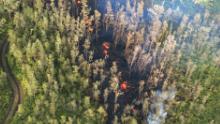

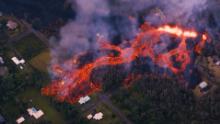
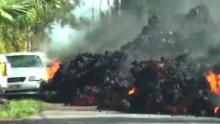
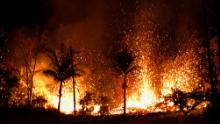
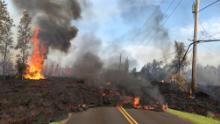
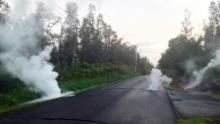
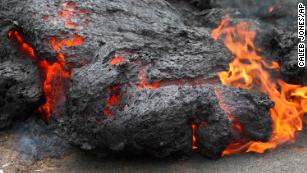
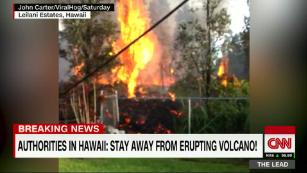
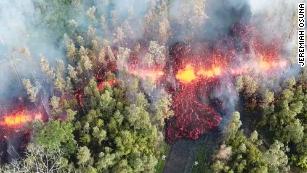
No comments:
Post a Comment